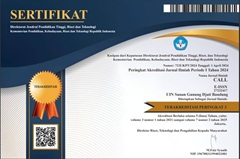NEGATIVE POLITENESS STRATEGY IN A STAND-UP COMEDY
DOI:
https://doi.org/10.15575/call.v6i1.19740Abstract
The aim of this study was to identify the factors influencing Trevor Noah’s use of negative politeness strategies in his stand-up comedy special “Atlanta Afraid of the Dark†(2016). Employing a qualitative descriptive approach, the research examined and explained the types and influencing factors of negative politeness strategies in Noah’s performance. The study utilized Brown and Levinson’s theories on politeness strategies, particularly negative politeness, to identify and categorize these strategies and their influencing factors. Additionally, Ramon Papana’s framework for the structural build of stand-up comedy techniques was used to analyze the elements of Noah’s comedy. The study found that Noah frequently used impersonal humor in his jokes. It also revealed that social context significantly impacted the content of the jokes, with Noah purposefully addressing social issues. The findings showed that Noah’s humor often employed negative politeness techniques, such as being indirect, questioning, hedging, and depersonalizing both the speaker and the listener. In conclusion, the negative politeness strategies of pessimism, questioning, hedging, and depersonalization played a crucial role in delivering the punchlines. Additionally, callbacks were created using negative politeness methods, such as showing deference and apologizing.
Keyword: comedy, politeness strategy, negative politeness strategy
References
Brown, P., & Levinson, S. C. (1987). Politeness: Some universals in language usage. Cambridge: Cambridge University Press.
Haugh, M. (2010). 11. Respect and deference. In M. Locher & S. Graham (Ed.), Interpersonal Pragmatics (pp. 271-288). New York: De Gruyter Mouton.
Hartati, S. (2020). Negative politeness strategies of Ahok’s statements in Mata Najwa talk show. Jurnal Pujangga, 6(1), 75-87.
Hobjilă, A. (2012). Positive politeness and negative politeness in didactic communication – landmarks in teaching methodology. Procedia - Social and Behavioral Sciences, 63(2), 213–222.
Kurniawan, N. (2015). An analysis of positive and negative politeness strategies in an interview of mark rutte on metro Tv’S Face 2 face with Desi Anwar Program. Positive and Negative Politeness, 1–66.
Limon, J. (2020). Stand-up Comedy in Theory, or, Abjection in America. Stand-up Comedy in Theory, or, Abjection in America. https://doi.org/10.1515/9780822380504
Mujiono. (2015). A study on politeness strategies of characters in the big wedding movie directed by Justin Zackham. Jurnal Ilmiah Bahasa Dan Sastra, 2(1), 45-55.
Njuki, E., & Ireri, H. K. (2021). Positive and negative politeness strategies used by Kenya’s members of National Assembly. OALib, 08(08), 1–20.
Noah, T. (2018). Trevor Noah Born in Crime. https://www.trevornoah.com/about
Papana, R. (2016). Buku besar standup comedy (1st Ed). Jakarta: PT Elex Media Komputindio.
Sangweni, Y. (2020, October 28). celebrity/trevor-noah-talks-being-south-african-comedian/. Retrieved from Essence: http://www.essence.com
Selfia, M., Marlina, L. (2016). An analysis of politeness strategies used by Deddy Corbuzier in hitam putih talk show. E-Journal English Language and Literature, 5(1), 19-28.
Siregar, D. Y. (2018). The analysis of the three levels of communication in Mata Najwa talk show. VISION: Journal of Language, Literature & Education, 14(14), 1–14.
Winarsih, S. (2020). Stand-up comedy: the relation between language and culture. Jurnal Kajian Linguistik, 8(1), 2685–3744.
Downloads
Published
Issue
Section
Citation Check
License
Authors who publish in CALL agree to the following terms:
- Authors retain copyright and grant the journal right of first publication with the work simultaneously licensed under Attribution-ShareAlike 4.0 International (CC BY-SA 4.0) License that allows others to share the work with an acknowledgment of the work's authorship and initial publication in this journal.
- Authors are able to enter into separate, additional contractual arrangements for the non-exclusive distribution of the journal's published version of the work (e.g., post it to an institutional repository or publish it in a book), with an acknowledgment of its initial publication in this journal.
- Authors are permitted and encouraged to post their work online (e.g., in institutional repositories or on their website) prior to and during the submission process, as it can lead to productive exchanges, as well as earlier and greater citation of published work (See The Effect of Open Access).




